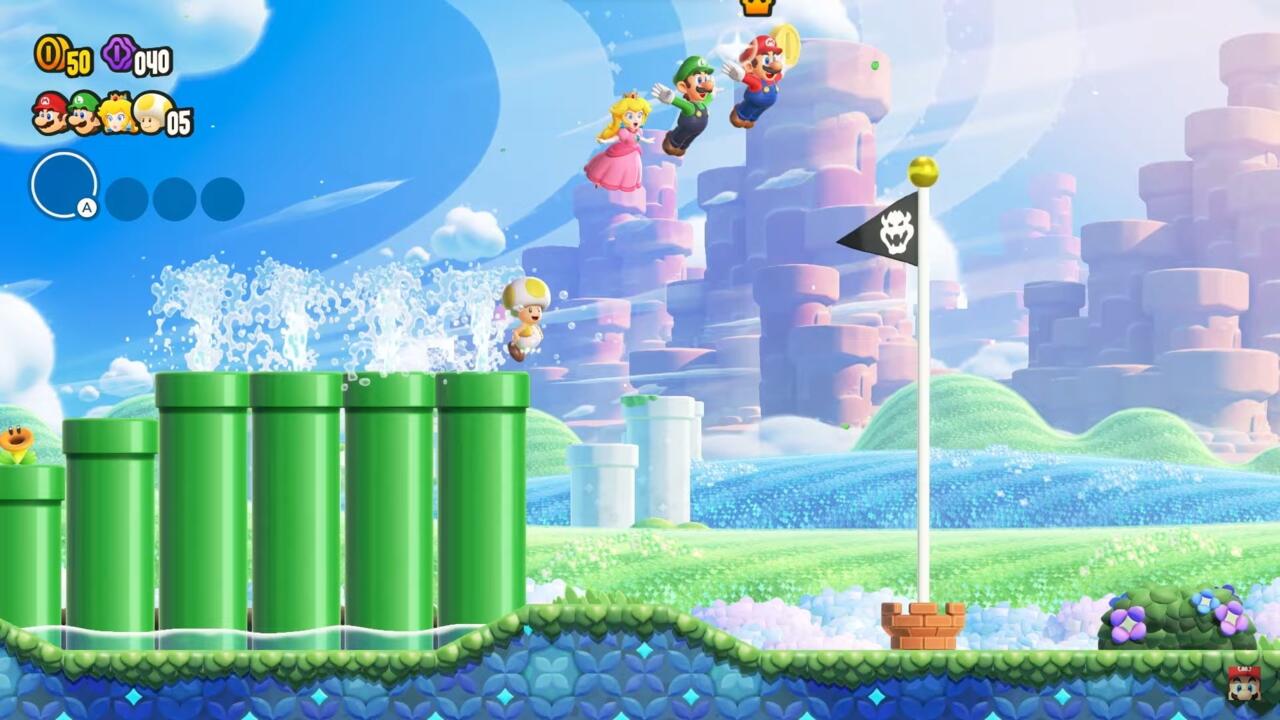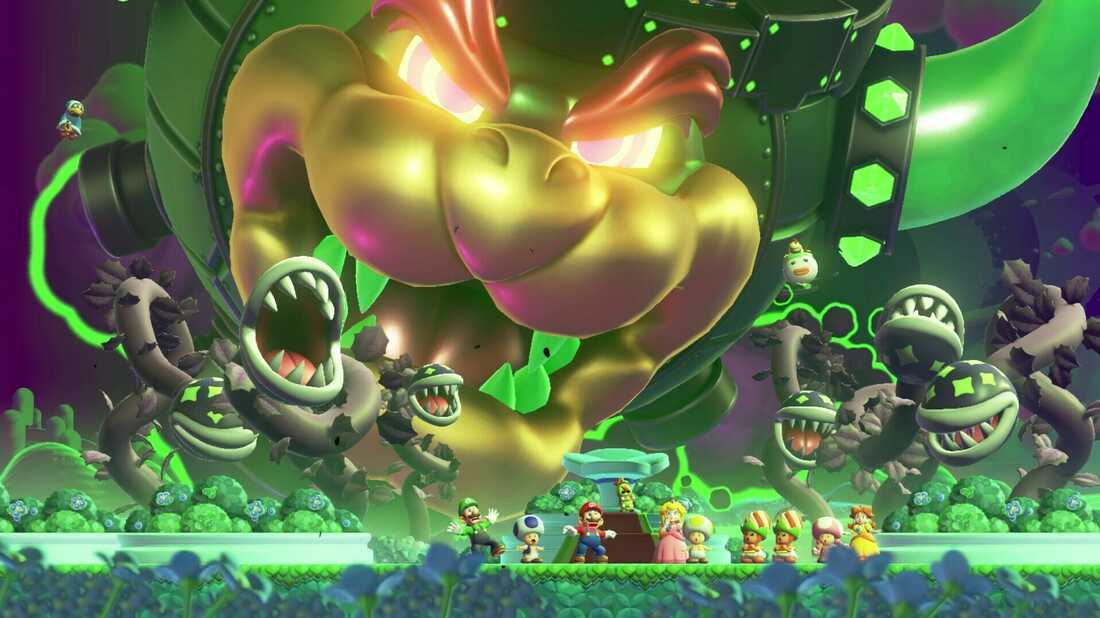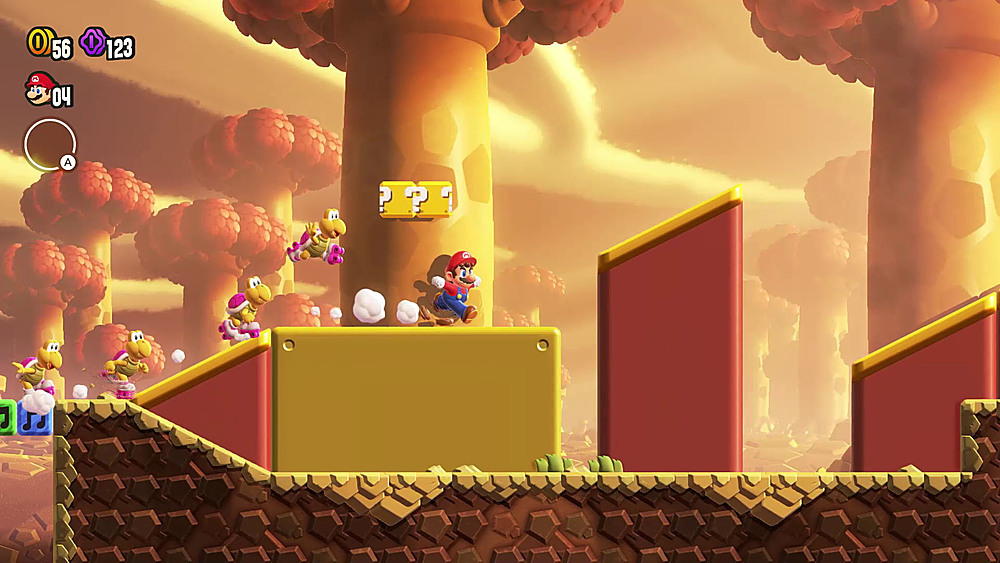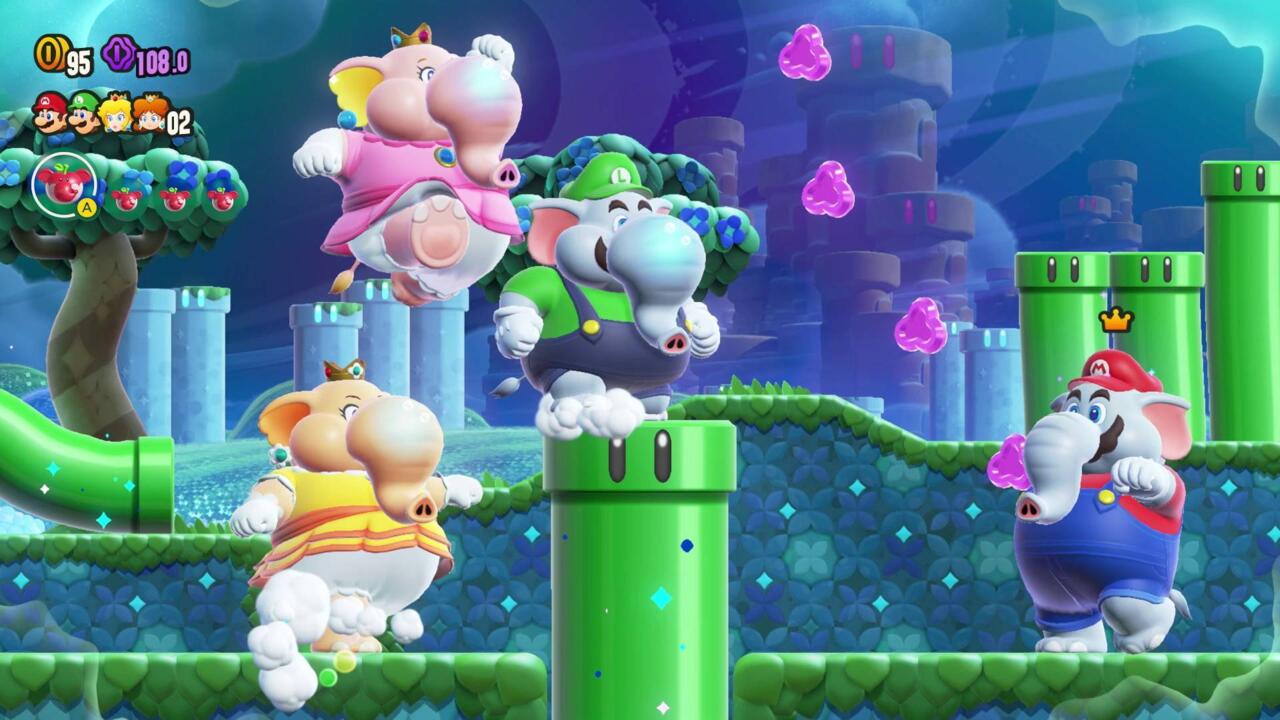Whether its adventures in 2D or 3D, the Mario franchise has repeatedly delivered fresh, fun, and fascinating gameplay concepts that elevate and reinvent the platforming genre. It’s this focus on ensuring new ideas are explored that has allowed the character, and the games he has featured in, to become an enduring part of the video game landscape.
For Super Mario Bros. Wonder, the latest entry in the 2D side-scrolling branch of the Mario franchise, Nintendo has leaned further into doing what it takes to ensure its game design ideas don’t stagnate. Whereas previous Mario games have introduced one central concept that is then pulled and picked at from different angles to support a multi-hour gameplay experience, this one seems to introduce ideas with almost overwhelming regularity, positioning Wonder to be a game that is bursting with new ideas and unexpected twists on old ones.
To learn about Nintendo’s new approach to making Super Mario Bros. Wonder, and the impact it has had on the design and development of the game, GameSpot’s Tamoor Hussain and Lucy James spoke to Nintendo’s Shiro Mouri and Takashi Tezuka, director and producer on the game respectively during PAX West 2023. Translations were done through Nintendo’s representatives.
GameSpot: Wonder is very different from previous 2D Mario games, but also quite familiar in some ways. What was your intent coming into this game and what did you want to achieve with it?
Mouri: So when we were making this new 2D Mario there were two concepts that we wanted to explore. The first concept is « packed with secrets and mysteries » and the second one is « freedom of choice. » So I’ll start off with the first one–packed with secrets and mysteries. So I believe that the original Super Mario Bros. was a game packed with secrets and mysteries. So some of those secrets and mysteries are, of course, grabbing a mushroom that makes you bigger or going down a pipe which you thought was an obstacle but actually leads you to a secret underground area. Those are all secrets and mysteries.
But what we realized was a new challenge that surfaced, [which] was the fact that these secrets and mysteries that we’ve been including in these games have become standardized. And there’s something we did to kind of combat and overcome that challenge. What we wanted to do was create a new version of the tried and true method of going down the pipe [or accessing] a secret underground area or climbing a vine to access a secret sky area. So what we did specifically was that you would get warped to a different area if you grab an item. We made it and showed it to Mr. Tezuka and he said, « Well, if you’re just going to warp to an area, it’s the same. Can’t you change where you are right now? »
So I thought, « Change, okay. » But rather than focus on just one particular space or part of the course changing, I thought, « Why not just change the entire course? » So some of the things we tested out were, for example, what if the pipes started wiggling around and came to life? What if the entire screen tilted one way? What if we had to travel across on top of a hoard of enemies? And this is really the conception of Wonder.

Tezuka: Really, there was a lot of work involved in creating just one Wonder. So I think that at the time when I brought this up, [I] was really envisioning maybe a couple Wonder over a couple of different courses. But then I suggested, « I know it’s a lot of work, but how about creating a Wonder for each and every main course? »
Mouri: So the thing about Wonder is, even making one is a lot of work, but on top of that, you have to consider that there’s a course with Wonder and there’s a course without Wonder. So what that means is that we need to create a course that’s obviously fun to play, but also a course that’s fun to play with the Wonder effect after [collecting] the Wonder Flower. And we need to do that for all main courses.
So with Mr. Tezuka’s suggestion, we started to embark on this journey and there’s something that we realize[d] or learned: Going back to our first concept of packed with secrets and mysteries, we realized that unless every single main course has a Wonder, we can’t create a game that’s packed with secrets and mysteries. So to realize this, what we did was [ask] the entire team for ideas. And when we pooled the team for ideas, it didn’t matter how long they’ve been working in Nintendo, it didn’t matter what part of the game they were working on, we pooled the entire team. So there’s over 2,000 ideas that came out of this. And from that we narrowed it down to those that have potential.
And once we made prototypes of those ones with potential, we got ideas of, « Well, maybe we should change it this way to make it fun, or maybe we should do this to make it more interesting. » It was this layering of ideas that the entire team started to do together [that was] how we were able to actually realize putting a different Wonder in every single main course.
Tezuka: From sort of the beginning of development to the midsection of development, we were still not 100% certain on what Wonder would be or even if we’d be able to do it. Now, of course, the thing that we did set as a goal that we had to accomplish was make sure that we had a Wonder for each and every course. And so what we decided to do in order to meet that goal was to not put a particular deadline for the creation of those Wonders. And so we figured that once we got our feet underneath us and we’re able to create these Wonders at a regular pace, then we would go ahead and establish that schedule with the deadline. But what we didn’t want is to allow folks to say, « We’re not going to meet the schedule, we’re not going to meet the deadline, therefore we can’t do this. » We didn’t want to have that built-in excuse for that.

Mario games are very creative, but generally, there’s one core idea that is explored in a bunch of different ways, but this feels like a bunch of Mario ideas all in one. Did the team have any trouble adjusting to that approach and potentially changing a working formula or was it really easy for them to come up with these ideas and just bundle them in?
Tezuka: I do think we could have a different development style than we have previously, but I think that people were very excited about it. We wanted to have an environment where right from the beginning everybody felt comfortable bringing out all of their ideas. So rather than having the set formula or the set concept to build around, we really wanted them to be active in helping us create that foundation or that kernel [for Wonder]. For example, the sound staff usually comes in about midway through development to start their own work. But actually, [for Wonder they were there] right from the very beginning. We actually solicited a lot of ideas from the sound staff. We haven’t really talked about or introduced a lot of it, but we have a lot of really interesting ideas and content in the game that came from our sound team. I think they were able to enjoy a bit of a different development process than they’ve had in the past.
One of the things I’m really interested in is there was no timer on the level, and it made me think about the pace at which you play a Mario game, especially one with this many ideas in it. Are you trying to encourage a slower pace of play for Wonder so people can look around, figure things out, and have fun with these tools?
Mouri: I’ll start off by saying that I think at the very fundamental level, [2D] Mario games are not an exploration game. It’s a game where you start from the start and get to the goalpost. And going back to the concepts we have for this game, [one is] freedom of choice. So within that concept of freedom of choice, one discussion we had within the team was, « What are we going to do with the timer? » So we just gave it a shot and removed the timer. And what we discovered and were able to actually experience was that even without the timer, the fundamental goal of reaching the goalpost is still there and the game is still there, but it also provided a lot more freedom and choice for the player, and that’s why we decided to implement [the idea].
Tezuka: So actually if you look back at why the timer in Mario games exists originally, that’s an interesting conversation. When you’re playing a game, there comes a point where you get stuck, you’re kind of trapped, and you can’t move forward. But if there’s a timer, it just kind of forces you to get past that point. That’s really just a piece of a game specification that’s just sort of a holdover from that original creation of Mario titles. And because it was something that’s just been such a core concept or a fundamental piece of Mario from the beginning, I think it was a point of conversation amongst our younger staff members on whether or not it was something that could be removed safely.


One of the other interesting things I’d love to hear more about is the decision to have the camera follow the one main person. It feels like it encourages more considered cooperation. What was the thinking behind that?
Mouri: Yeah, there’s certainly intent behind wanting to create a more cooperative environment. And this time we really did a lot of trial and error and thinking around what we’re going to do with the camera, especially with multiplayer. So multiplayer was something that has been around since the Wii, and back then we had the camera pan when two characters went the opposite direction. And while that was good, with the Nintendo Switch, some people will play in tabletop mode. And when you’re playing in tabletop mode, the panning out of the camera then becomes a new problem because everything becomes so small and hard to play. We thought, aside from that, rather than having a camera that constantly zooms in or out, it’s a more comfortable gameplay experience to be able to play with this camera that’s a lot more stable. So again, taking into consideration the fit for the Nintendo Switch, the stability, and then also what you had mentioned–the kind of intent to provide a cooperative environment–all those put together is why we decided that rather than having a camera that kind of zooms in and up, to have a camera that follows, say, the crowned player.
How did you come up with the badge system, and what does it bring to a 2D Mario experience?
Mouri: I think there’ve been several Mario games in the past where characters have a specific set of abilities. So for example, Peach being a little bit floaty and Luigi being able to jump high. With that said, I’m sure there’s people who wanted maybe a floaty Mario or a Toad that can jump high. And again, you have the concept of secrets and mysteries, but there’s also going back to the concept of freedom of choice. And so we came to the conclusion that maybe it’s better to be able to select the character you want and then add the ability you want. And that’s how the badge system came to be.
What the badge system allows you to do is add any action you want to the character. And this isn’t only limited to action, so you can have a badge that automatically rescues you when you fall down a pit, being kind of like a rescue option for potentially novice players. And then there’s badges that are maybe for advanced players like being invisible. I think what this allows for the game is to introduce a system that allows for both novice players all the way up to advanced players to really enjoy their gameplay experience.
Tezuka: Yeah, and if I add a little bit to that, in Mario games there’s courses that require specific techniques that you have to master to clear, but in this title we have more choices. And among those your own ideas become sort of a choice. I do think that incorporating what Mr. Mouri has described lets the player think of different ways for themselves to play in the ways that they like, and that further moves us towards achieving that goal of freedom of play or freedom of choice.
In the previous multiplayer Mario games you had the ability to physically interact with other members of your team–for better or worse. I noticed in Wonder that isn’t the case anymore. Was there a specific takeaway from previous games where you could interact that made you reevaluate that dynamic for Wonder?
Mouri: So actually, when we initially started development on this, there was collision between characters. But this time around we have the very big Elephant Mario, and there’s also a Mario that’s very, very tall with the effects of Wonder. When those two collide, it’s a level of stress that hasn’t been seen thus far. And something we really put our focus and energy in this time around multiplayer is the idea of making it a stress-free experience. So when we took the jump and removed the collision completely, we realized that it provides a very smooth, stress-free experience. Another simple example of a stress-free experience is the fact that maybe you have a narrow platform, but with collision people might get in the way and you just fall. But without collision you can land safely and make a jump. Another reason we wanted to remove the collision was the fact that having multiplayer without collision would just provide an entirely new multiplayer experience. And hence, that’s why we decided to move forward with this spec.
The characters are very, very expressive. What was the thinking behind placing more emphasis on making the characters way more expressive in this game?
Tezuka: Really, up to now, if I look at our previous development pattern, a lot of development costs went into the creation of the gimmicks and the items and the enemy characters. The [number of] expressions was at a cap where we limited that development cost. And so at the beginning [of Wonder development] we just said, « You know what? Just do what you want to do, have the freedom to create the way you want to create. » And I think people looked at it and, as players, said « I would be happy to see this sort of expression within the game. » And our designers, artists, programmers, and sound designers all came at it from being on the same page with the same viewpoint. So, for example, « If you run into one of the Koopa Troopas and they have this expression when you hit them, I would love to see that reaction from a Koopa Troopa. And if we’re able to have this sort of expression and these animation movements, let’s create levels around those so that we can highlight these things. »


Why an elephant? And does it have any significance for the game? And also how do you pick the animal that Mario is going to transform into?
Mouri: So first off, I’ll start by saying that it’s not like we’re set on making an animal of sorts. It always starts with the gameplay experience that we want to provide. So talking about the Elephant Mario, there’s three things that we wanted to accomplish. The first one is to make the body bigger. And the reason for that is that if you have a bigger body, it’s easier to hit blocks, it’s easier to stomp enemies, and collect coins. We thought that bringing a change to the fundamental mechanics of Mario’s movements might be a refreshing experience. The second one is to be able to hit blocks from the side, and by being able to hit blocks from the side, it provides an opportunity for the players to have an area where you can only access through that transformation.
The third one is [the ability to] spray water. An idea we had was, « What if there’s a withered flower that if you water something happens? » So with the [theme] of, again, « packed full of secrets and mysteries, » we thought that having something like this would really contribute to that. And so we have, again, these three gameplay experiences we want to provide: bigger body, hitting blocks from the side, and spraying water. And we racked our brains to come up with the optimal way to realize this. No matter how hard we thought, the only optimal solution was an elephant.
You both have worked on Mario for a really long time and worked on numerous beloved 2D entries, and it’s one of the few characters and franchises that has endured in a classic way and a new way. We have the 2D Mario, and we have the 3D Mario games now. What do you think about Mario as a franchise allows it to remain so relevant and fresh each time, so that they can coexist and almost like be different experiences entirely?
Tezuka: Well, let’s start with 2D Mario: I think the fundamental gameplay, that concept hasn’t changed. So the enjoyment is in you having a starting place, you have a goal, and you get from one point to the other through your own ideas on how to play and how you improve your own skill set. Our younger staff members have added to that formula by coming up with ways that they think would be fun to play. So that is to say the people who are creating the games have changed. With the growth and the number of people involved, the hopes or the goals for the title have also changed.
So if we compare it to titles in the past, we just had more brain power. And I think that has allowed us to create Mario for each generation or each age in which we are creating that Mario. And I think 3D Mario really follows the sort of the same ideas in its creation as well. Now, of course there are different things to enjoy in 3D Mario and 2D Mario, and I don’t think either one of them will supersede the other. We’re not going to see the other fade out. This is something that Nintendo will continue to create going forward, both 2D and 3D Mario experiences.
How does it feel to be making a new 2D Mario game? Do you feel the pressure of the lineage of that series when you come to a new one?
Tezuka: Yeah, I mean, if I look back and think about it, yeah, there was pressure, and [is] until what we have created is something that is going to be found enjoyable by our consumers, [which is] something we’re not going to be able to confirm until it’s on sale. So of course we make it with a lot of effort and a lot of feeling, but whether or not that is conveyed to the consumer is, again, something we have to wait and see. But we’re really looking forward to seeing how it’s accepted or how it’s received.
The products discussed here were independently chosen by our editors. GameSpot may get a share of the revenue if you buy anything featured on our site.










